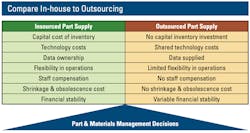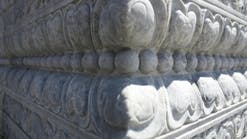One of the most vulnerable is the supply of repair parts and materials. Disruptions in parts and material supply caused by external forces can lead to equipment downtime and additional cost.
Find more on asset management.
Equipment managers must monitor part and supply operations to ensure fleet requirements are being met. Construction equipment has become increasingly complex, and volumes of data are now available for equipment managers to better manage such critical functions of the maintenance operation. Managers must analyze parts and material supply functions and adapt to changes within the supply chain to remain competitive.
Repair part and material supply is a core function of the equipment maintenance management operation. On average, parts and materials account for between 35 percent and 45 percent of the total cost of running a maintenance operation. Part and material supply operations provide all preventive maintenance and repair parts required to keep the equipment productive. In addition, all general materials classified as shop stock—such as wire connectors—and general shop supplies are procured, inventoried, and managed by the part and supply operation.
Determining the method of operating and managing the part and supply operation, whether internal or outsourced, has become increasingly critical to maintain shop and field service schedules. Equipment managers must first analyze their fleet’s available parts and material data to identify the maintenance operations’ supply requirements. Only then can they decide whether to utilize internal staff, outsource the function to OEM or contracted suppliers, or use a combination of both.
Keep supplies in-house
Internally supported repair part and material supply has been the most common and preferred method. Under the direct control of the equipment manager, internal operations offer the greatest flexibility to respond to rapidly changing requirements, repair priorities, and just-in-time operations. This method allows for real-time adjustments of inventory levels as equipment enters and leaves the fleet, or as repair priorities are adjusted. Inventory turn and fill rate data is specific to the organization’s equipment and validates required inventory min/max levels, space requirements, and staffing levels.
Internal part and material supply managers and technicians are an integral part of the organizational team. They can leverage the organization’s purchasing volume to openly negotiate with multiple suppliers. Over time, they build relationships with primary, secondary, and third-source suppliers to ensure part and material availability to maximize equipment productivity. Communication and support of operational and repair priorities are maximized as both maintenance and part technicians fall under the same chain of command, increasing cohesiveness and focus on organizational productivity.
An internally managed part and material supply operation requires significant up-front investment. Capital funding is needed to stock inventory and to purchase inventory-management systems and required technologies. Staff compensation, office equipment, and space requirements all fall into the overhead costs of the equipment maintenance function and must be recaptured through the equipment rate. Inventory shrinkage and obsolescence costs, while minimized by internal flexibility and real-time inventory adjustments, add additional cost to the overall operation.
Outsource parts supply
Outsourced part and supply operations change the equipment manager’s role from operational supply stream oversight to the monitoring of a supplier’s contract. Outsourced operations require contractual service-level agreements as well as provisions for periodic amendments to maintain flexibility to changing requirements such as repair priorities and just-in-time repair part and material operations. The contracted supplier manages primary and secondary sourcing options to ensure part and material availability, requiring only periodic monitoring by the equipment management team. The vendor will supply data validating inventory, turn rates, min/max levels, and other essential supply metrics.
Contracted part and material supply companies leverage their overall purchasing volume to negotiate with large national suppliers to obtain deep discounts in various line item cost. Using this volume, they also contract with primary, secondary, and third-source suppliers to ensure part and material availability to maintain contractual obligations. Actual part and material costs, overhead, and profit margins are all included within the contracted markup.
The equipment team must maintain continuous and effective communication with the vendor management team. Loyalty of the vendor management team is to the contracted vendor, which could potentially lead to maintenance technician/parts technician conflict. Ideally, all should operate as one entity in pursuit of a common goal. A single point of contact to address changes in priority and other short-term operational changes should be clearly identified within the contract documents.
Outsourced supply operations reduce upfront capital costs as all inventory control and cost is borne by the contracted vendor. Inventory-management systems and required technologies are supplied by the contracted vendor. Similarly, operating costs are reduced as part and material supply staff compensation packages are the responsibility of the vendor. The vendor is also responsible for inventory shrinkage and obsolescence costs.
Technician part and material order time is reduced as they simply relay the asset control number of the equipment being worked on, the work order number, and the required parts. The contractor has the obligation and responsibility of the time spent to obtain and deliver the parts on time keeping the technician productive and on schedule.
In either option, managers should also use line item consignments. Part and material consignments relieve inventory and capital cost requirements as they are monitored and managed by third- or fourth-party suppliers specific to the product line. Parts are inventoried and housed within dispensers similar to vending machines, and vendors are paid as parts are dispensed.
Larger organizations with expansive geographical territory and many maintenance facilities should consider both options. Insourcing the function at large maintenance facilities and outsourcing it at smaller or remote facilities and specific job sites may bring the most efficient repair part and supply operations to the organization.
Over time, diversification and the comparison of each option may confirm either the insourced or outsourced option, or the continuation of a diversified plan. In the end, it is the equipment manager’s responsibility to ensure reliable and timely parts and materials to maximize production. The data will depict the most economical method.







